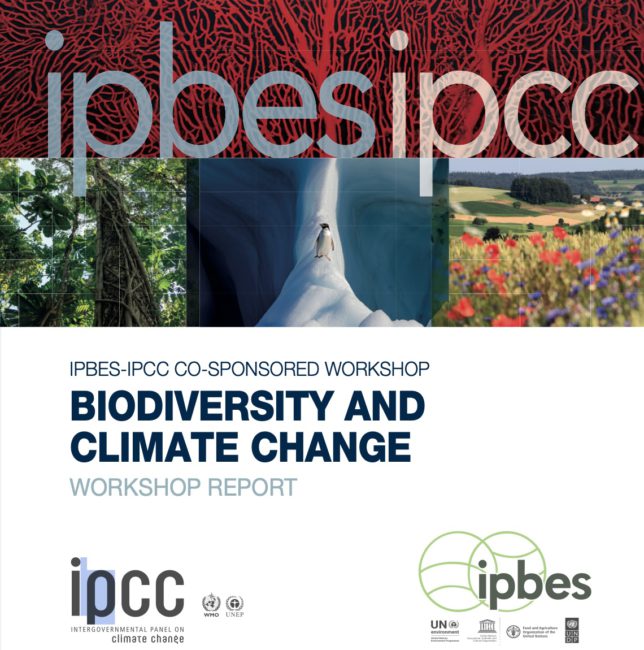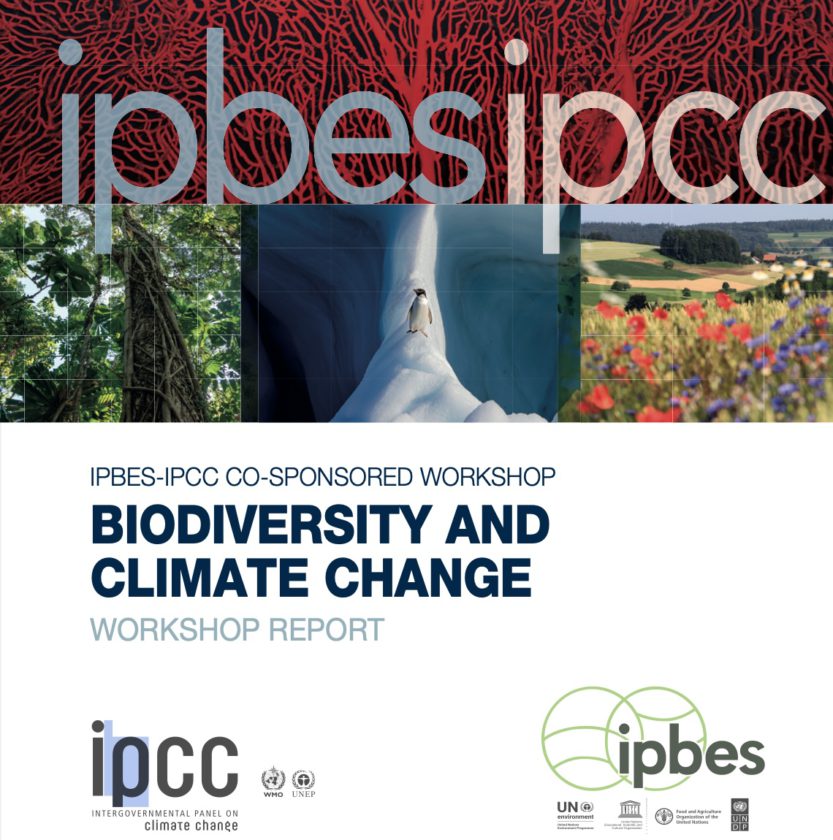
As a species we face many challenges. One is the considerable and ongoing loss of previously existing Biodiversity. Another top one is Climate Change. When faced with both of these, then which is the most important and so which one do we need to focus all our efforts upon first?
It’s a False Choice
Not only are both equally important, but both are also deeply interrelated and tightly coupled together. We can’t just solve one, we need joined up thinking to tackle both.
There is a new report that highlights this.
Launch of IPBES-IPCC Co-Sponsored Workshop Report on Biodiversity and Climate Change
OK, Acronym soup, so let’s decrypt who these organisations are.
- IPBES = the United Nations’ Intergovernmental Science-Policy Platform on Biodiversity and Ecosystem Services
- IPCC = the United Nations’ Intergovernmental Panel on Climate Change
Each, in isolation, is tightly focused on a key challenge.
Together, they have held a 4 days workshop and as a result produced a joint report that includes joined up thinking.
Various media articles have appeared and have covered the details. They don’t tell you where you can find the actual report. (See here in Wired). Now don’t misunderstand me. That article is fine, well-written, and articulates it all very well. It gushes on about the report and what is in it, but fails to tell you where the report can be found.
Oops.
So let’s correct that.
The key launch pad for all the details can be found on the IPBES page which is here.
From there you can find …
- The alpha source for all the media report – the press release
- the actual report itself. (24 pages)
They actually have links to a great deal more. As a international scientific body they are, as you might expect and anticipate, very transparent, and provide everything. It is not about churning out propaganda for political purposes, nor is there a specific agenda. This is a scientific body. For the scientific community they have a full report which is far more detailed and highly referenced – you can find that here. (Warning it runs to 230 pages).
Joined up thinking – What is the conclusion, what do we need to do?
There are no deep dark secrets here, nor will you find any shocking revelations. What the report articulates is the obvious. The article I refer to earlier does a fine job of laying it all out and articulates it rather well, so I don’t need to repeat all of that, but instead can simply refer you to that article by Matt Simon. (That’s just a personal recommendation, I don’t get paid for linking to it).
However, let me also lay out the highlights anyway via a bit of press release cut-and-paste.
What are the most important Actions?
Among the most important available actions identified in the report are:
- Stopping the loss and degradation of carbon- and species-rich ecosystems on land and in the ocean, especially forests, wetlands, peatlands, grasslands and savannahs; coastal ecosystems such as mangroves, salt marshes, kelp forests and seagrass meadows; as well as deep water and polar blue carbon habitats.
- Restoring carbon- and species-rich ecosystems. The authors point to evidence that restoration is among the cheapest and quickest nature-based climate mitigation measures to implement – offering much-needed habitat for plants and animals, thus enhancing resilience of biodiversity in the face of climate change, with many other benefits such as flood regulation, coastal protection, enhanced water quality, reduced soil erosion and ensuring pollination. Ecosystem restoration can also create jobs and income, especially when taking into consideration the needs and access rights of indigenous peoples and local communities.
- Increasing sustainable agricultural and forestry practices to improve the capacity to adapt to climate change, enhance biodiversity, increase carbon storage and reduce emissions. These include measures such as diversification of planted crop and forest species, agroforestry and agroecology. Improved management of cropland and grazing systems, such as soil conservation and the reduction of fertilizer use, is jointly estimated by the report to offer annual climate change mitigation potential of 3-6 gigatonnes of carbon dioxide equivalent.
- Enhancing and better-targeting conservation actions, coordinated with and supported by strong climate adaptation and innovation. Protected areas currently represent about 15% of land and 7.5% of the ocean. Positive outcomes are expected from substantially increasing intact and effectively protected areas. Global estimates of exact requirements for effectively protected and conserved areas to ensure a habitable climate, self-sustaining biodiversity and a good quality of life are not yet well established but range from 30 to 50 percent of all ocean and land surface areas. Options to improve the positive impacts of protected areas include greater resourcing, better management and enforcement, and improved distribution with increased inter-connectivity between these areas. Conservation measures beyond protected areas are also spotlighted – including migration corridors and planning for shifting climates, as well as better integration of people with nature to assure equity of access and use of nature’s contributions to people.
- Eliminating subsidies that support local and national activities harmful to biodiversity – such as deforestation, over-fertilization and over-fishing, can also support climate change mitigation and adaptation, together with changing individual consumption patterns, reducing loss and waste, and shifting diets, especially in rich countries, toward more plant-based options.
Does anything there actually surprise you?
They do also flag up things that might on the surface appear to be good, but are in reality very bad ideas.
What should we not be doing?
Planting stuff might come across as a great idea. “Look a empty space, let’s go fill it with plants or trees“. It turns out that not thinking it through carefully can end up having dire consequences.
- Planting bioenergy crops in monocultures over a very large share of land areas. Such crops are detrimental to ecosystems when deployed at very large scales, reducing nature’s contributions to people and impeding achievement of many of the Sustainable Development Goals. At small scales, alongside pronounced and rapid reductions in fossil-fuel emissions, dedicated bioenergy crops for electricity production or fuels may provide co-benefits for climate adaptation and biodiversity.
- Planting trees in ecosystems that have not historically been forests and reforestation with monocultures – especially with exotic tree species. This can contribute to climate change mitigation but is often damaging to biodiversity, food production and other nature’s contributions to people, has no clear benefits for climate adaptation, and may displace local people through competition for land.
- Increasing irrigation capacity. A common response to adapt agricultural systems to drought that often leads to water conflicts, dam building and long- term soil degradation from salinization.
- Any measures that focus too narrowly on climate change mitigation should be evaluated in terms of their overall benefits and risks, such as some renewable energies generating surges of mining activity or consuming large amounts of land. The same applies to some technical measures too narrowly focused on adaptation, such as building dams and sea walls. Although important options for mitigating and adapting to climate change exist, these can have large negative environmental and social impacts – such as interference with migratory species and habitat fragmentation. Such impacts can be minimized, for instance, by developing alternative batteries and long-lived products, efficient recycling systems for mineral resources, and approaches to mining that include strong considerations for environmental and social sustainability.
Biodiversity or Climate Change?
If I now asked you some questions on the above, would you be able to answer them?
I suspect most, including myself, could not.
OK, so let’s be realistic about this. Please consider taking away one key observation from all of this. When it comes to Biodiversity decline and Climate Change, it is not an either or choice. We need to take steps that address both.
Joined up thinking is needed because these are issues that each impact the other.
Climate Change (for example warming oceans) will impact Biodiversity and cause more loss (wave bye bye to coral reefs)
Biodiversity loss (think cutting down vast swathes of the Amazon), will cause more Climate change.
In other words, each problem feeds the other, and so we really have no choice here, we must tackle both together. Please embrace that insight.
To drill this point home, here below are a few quotes from the subject matter experts …
“Transformative change in all parts of society and our economy is needed to stabilize our climate, stop biodiversity loss and chart a path to the sustainable future we want. This will also require us to address both crises together, in complementary ways.”
Ana María Hernández Salgar, Chair of IPBES
“Climate change and biodiversity loss combine to threaten society – often magnifying and accelerating each other.”
Dr. Hoesung Lee, Chair of the IPCC
“Policies, efforts and actions to solve the global biodiversity and climate crises will only succeed if they are based on the best knowledge and evidence, which is why Norway welcomes this expert workshop report. It is clear that we cannot solve these threats in isolation – we either solve both or we solve neither.”
Sveinung Rotevatn, Norwegian Minister for Climate and Environment
(Taps microphone) … hello, hello, is this thing on, is anybody listening?
